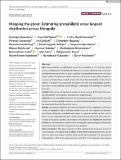Mapping the ghost : estimating probabilistic snow leopard distribution across Mongolia
Abstract
Aim Snow leopards are distributed across the mountains of 12 countries spread across 1.8 million km2 in Central and South Asia. Previous efforts to map snow leopard distributions have relied on expert opinions and modelling of presence-only data. Expert opinion is subjective and its reliability is difficult to assess, while analyses of presence-only data have tended to ignore the imperfect detectability of this elusive species. The study was conducted to prepare the first ever probabilistic distribution map of snow leopards across Mongolia addressing the challenge of imperfect detection. Location We conducted sign-based occupancy surveys across 1,017 grid-cells covering 406,800 km2 of Mongolia's potential snow leopard range. Methods Using a candidate model set of 31 ecologically meaningful models that used six site and seven sampling covariates, we estimate the probability of sites being used by snow leopards across the entire country. Results Occupancy probability increased with greater terrain ruggedness, with lower values of vegetation indices, with less forest cover, and were highest at intermediate altitudes. Detection probability was higher for segments walked on foot, and for those in more rugged terrain. Our results showed broad agreement with maps developed using expert opinion and presence-only data but also highlighted important differences, for example in northern areas of Mongolia deemed largely unfavourable by previous expert opinion and presence-only analyses. Main conclusions This study reports the first national-level occupancy survey of snow leopards in Mongolia and highlights methodological opportunities that can be taken to scale and support national-level conservation planning. Our assessments indicated that 0.5) probability of being used by snow leopards. We emphasize the utility of occupancy modelling, which jointly models detection and site use, in achieving these goals.
Citation
Bayandonoi , G , Sharma , K , Shanti Alexander , J , Lkhagvajav , P , Durbach , I , Buyanaa , C , Munkhtsog , B , Ochirjav , M , Erdenebaatar , S , Batkhuyag , B , Battulga , N , Byambasuren , C , Uudus , B , Setev , S , Davaa , L , Agchbayar , K-E , Galsandorj , N & MacKenzie , D 2021 , ' Mapping the ghost : estimating probabilistic snow leopard distribution across Mongolia ' , Diversity and Distributions , vol. Early View . https://doi.org/10.1111/ddi.13412
Publication
Diversity and Distributions
Status
Peer reviewed
ISSN
1366-9516Type
Journal article
Description
We are grateful to Global Environment Facility, United Nations Development Program and Snow Leopard Trust for supporting the Global Snow Leopard and Ecosystem Protection Program and development of tools and methods for Population Assessment of the World's Snow leopards (PAWS).Collections
Items in the St Andrews Research Repository are protected by copyright, with all rights reserved, unless otherwise indicated.

